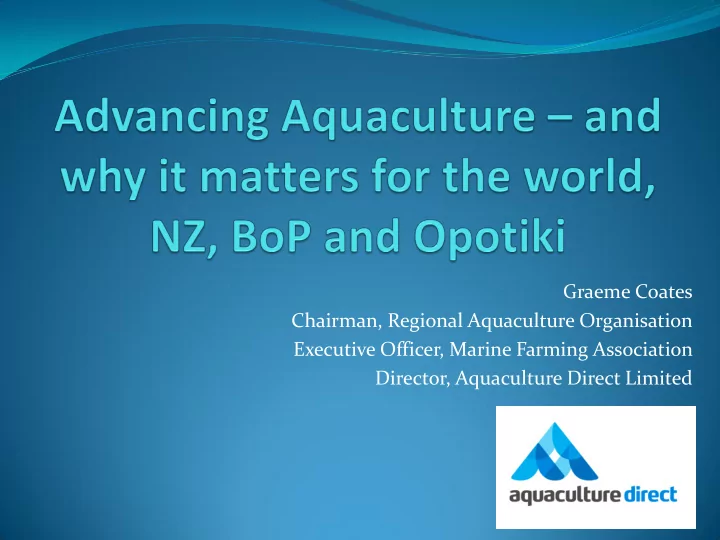

Graeme Coates Chairman, Regional Aquaculture Organisation Executive Officer, Marine Farming Association Director, Aquaculture Direct Limited
The World The Aquaculture sector is the fastest growing seafood sector The Food & Agriculture Organisation (FAO) predicts that global consumer demand for seafood will almost double from 45 to 85 million tonnes by 2020 It is estimated that aquaculture will increase from 42% to 58% of global seafood production by 2020 The growth in global fish protein consumption to 2020 will be from developing countries – over half of which will come from the Asia Pacific region
New Zealand New Zealand’s aquaculture produce is currently exported to 79 countries worldwide An industry drive supported by government, for new species development is assisting this sector to move towards new, high value species and value added products that promise to be the future of aquaculture in NZ
New Zealand Cont.. NZ is recognised as operating one of the strictest quality assurance programmes for shellfish in the world. NZ is also unique in the fact that it does not use antibiotics, pesticides, growth promotants or vaccines in Salmon Farming practices Sustainable aquaculture has the potential to make a significant contribution to New Zealand’s economy. Currently offering employment to over 3,000 people, this figure is expected to increase significantly within the coming years
New Zealand Cont.. Aquaculture activities in NZ take place within approximately 17,630ha of allocated water space. Of this: 41% are near-shore sites 51% are open-ocean sites 8% is undeveloped space in interim AMA’s Most of the open-ocean space is still in the early stages of development. Open-ocean aquaculture occurs in exposed sites which require more space between farm structures and different types of structures to those typically used. This limits stocking capacity, which means open-ocean aquaculture can have a lower yield per hectare than near- shore sites
NZ Grenshel™ Musel Exports 208 Greenshell TM Product Forms New Zealand Greenshell ™ Mussel exports 2008 Export % of % change on Product category Weight (kg's) exports 2007 exports 0.60% HS Frozen 27,990,138 84.06% Meat Frozen 2,906,762 8.73% -1.20% Whole Frozen 1,261,319 3.79% 0.56% Pre'ed/Marinated 448,723 1.35% 0.06% Live 430,337 1.29% -0.10% Freeze-dried pw d 201,447 0.61% 0.09% Other not L/Ch/Fz 20,311 0.06% 0.05% Meat Chilled/Frsh 8,917 0.03% -0.01% Whole Chilled 7,323 0.02% -0.04% Smoked 6,528 0.02% -0.02% Proc in Can, Jar 6,484 0.02% 0.01% HS Fresh/Chld 5,577 0.02% 0.00% Pow der in capsule 2,132 0.01% 0.00% Source: New Zealand Seafood Industry Council Ltd
Where do Greenshell TM Go? – Frozen half shell Year 2009 Other 24% Germany 3% Australia 3% United Kingdom 4% Hong Kong 4% Japan 4% Canada 4% Spain 5% South Korea 10% United States 39% 0 2,000 4,000 6,000 8,000 10,000 12,000 Weight (tonnes) Source: Aquaculture New Zealand Ltd – New Zealand Aquaculture Farm Facts June 2009
Where do Greenshell TM Go? – Frozen mussel meat Year 2009 Frozen Mussel Meat Other 12% Greece 3% Japan 4% Hong Kong 9% Spain 23% United States 23% Australia 26% 0 100 200 300 400 500 600 700 800 Weight (tonnes) Source: Aquaculture New Zealand Ltd – New Zealand Aquaculture Farm Facts June 2009
Tonnage and value of Greenshell exports from 1983 Estimated farm tonnage and value of Greenshell exports from 1983 - 2009 120000 250 100000 200 Export Value Millions 80000 150 Tonnage 60000 Tonnage 100 Export $ 40000 50 20000 0 0 1983 1984 1985 1986 1987 1988 1989 1990 1991 1992 1993 1994 1995 1996 1997 1998 1999 2000 2001 2002 2003 2004 2005 2006 2007 2008 2009 Year
Bay of Plenty Regionally supportive 1. Water Quality 2. Uniqueness 3. Growing areas/ opportunities 4. Infrastructure 5.
Opotiki Offshore site available 1. Enthusiastic supportive Council 2. Branding 3. Opportunity (technology / 4. species) Jobs, on water, in processing 5. plants Adding value 6.
Recommend
More recommend